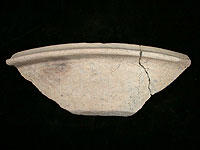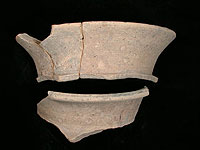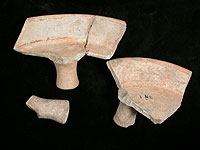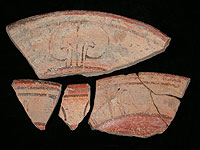A Description of the Bullard Collection
 One of the Florida Museum’s most important resources for Maya archaeology is a well-documented collection from the Petén Lakes region of Guatemala, excavated by William Bullard in the 1960s and later documented in publications (Bullard 1970, 1973). This collection includes chipped stone tools, spindle whorls, Postclassic effigy censer fragments, and collections of Classic, Terminal Classic, and Postclassic ceramic sherds from Ixlú, Topoxté, and the Macanché area in Petén. Guatemala. The excavated material dates between the Terminal Classic and Late Posclassic periods (ca. A.D. 850-1450). Some Preclassic and Classic sherds were found when excavating earlier contexts. These include Preclassic/Early Classic Flor Cream and Late Classic Polychrome types found at Ixlú, such as Orange Polychrome and Cream Polychrome (Rice 1987:85-89).
One of the Florida Museum’s most important resources for Maya archaeology is a well-documented collection from the Petén Lakes region of Guatemala, excavated by William Bullard in the 1960s and later documented in publications (Bullard 1970, 1973). This collection includes chipped stone tools, spindle whorls, Postclassic effigy censer fragments, and collections of Classic, Terminal Classic, and Postclassic ceramic sherds from Ixlú, Topoxté, and the Macanché area in Petén. Guatemala. The excavated material dates between the Terminal Classic and Late Posclassic periods (ca. A.D. 850-1450). Some Preclassic and Classic sherds were found when excavating earlier contexts. These include Preclassic/Early Classic Flor Cream and Late Classic Polychrome types found at Ixlú, such as Orange Polychrome and Cream Polychrome (Rice 1987:85-89).
 The Bullard collection has been analyzed by Prudence Rice in Macanché Island, El Petén: Excavations, Pottery and Artifacts (University of Florida Press 1987). Rice (1987) focuses her analysis primarily on the Terminal Classic and Postclassic ceramic types from Macanché Island. The Terminal Classic (A.D. 800 to 900/1000) Romero Complex can be compared to material collected elsewhere in Petén, especially the Bayal Complex from Seibal (Sabloff 1975). The Romero assemblage consists primarily of types from the Tinaja Ceramic Group, including Tinaja Red, Subin Red, and Chaquiste Impressed as well as examples of Cameron Incised and Pantano Impressed. Unslipped jars are primarily represented by types from the Cambio Ceramic Group. Other special types from the Bullard Collection include Achote Black, Harina Cream, Payaso Orange-Brown, Daylight Orange: Darknight, and various fine paste types, such as Jato Black-on-gray of the Danta Group.
The Bullard collection has been analyzed by Prudence Rice in Macanché Island, El Petén: Excavations, Pottery and Artifacts (University of Florida Press 1987). Rice (1987) focuses her analysis primarily on the Terminal Classic and Postclassic ceramic types from Macanché Island. The Terminal Classic (A.D. 800 to 900/1000) Romero Complex can be compared to material collected elsewhere in Petén, especially the Bayal Complex from Seibal (Sabloff 1975). The Romero assemblage consists primarily of types from the Tinaja Ceramic Group, including Tinaja Red, Subin Red, and Chaquiste Impressed as well as examples of Cameron Incised and Pantano Impressed. Unslipped jars are primarily represented by types from the Cambio Ceramic Group. Other special types from the Bullard Collection include Achote Black, Harina Cream, Payaso Orange-Brown, Daylight Orange: Darknight, and various fine paste types, such as Jato Black-on-gray of the Danta Group.
 Some similarities are noted between the Romero Complex and Terminal Classic ceramics found in western Belize, including the Spanish Lookout Complex, defined by James Gifford (1976) at the site of Barton Ramie, and the Tsak’ Complex defined by Lisa LeCount (2005) for the site of Xunantunich. The look and feel of the Tinaja Red ash paste, with its red slip, is similar to Belize Red (a common type in western Belize), however, the forms are markedly different. Tinaja Red primarily consists of jars with outflaring necks (Rice 1987:Fig. 31), while Belize Red consists primarily of dishes and bowls. The everted rims of the Cambio Unslipped jars from Macanché are similar to Terminal Classic examples of Cayo Unslipped jars from western Belize (Aimers 2004; Rice 1987:Fig. 35). However, the distinctive “pie crust lip” seen in Belize was not noted in the Terminal Classic assemblage at Macanché Island (Rice 1987:79). Mount Maloney Black, a common bowl form at Xunantunich, may be represented in the Bullard Collection (personal observation; LeCount, personal communication, June 2008). This Late-to-Terminal Classic type is defined as Achote Black in the Romero Complex (Rice 1987: Fig. 34a, c).
Some similarities are noted between the Romero Complex and Terminal Classic ceramics found in western Belize, including the Spanish Lookout Complex, defined by James Gifford (1976) at the site of Barton Ramie, and the Tsak’ Complex defined by Lisa LeCount (2005) for the site of Xunantunich. The look and feel of the Tinaja Red ash paste, with its red slip, is similar to Belize Red (a common type in western Belize), however, the forms are markedly different. Tinaja Red primarily consists of jars with outflaring necks (Rice 1987:Fig. 31), while Belize Red consists primarily of dishes and bowls. The everted rims of the Cambio Unslipped jars from Macanché are similar to Terminal Classic examples of Cayo Unslipped jars from western Belize (Aimers 2004; Rice 1987:Fig. 35). However, the distinctive “pie crust lip” seen in Belize was not noted in the Terminal Classic assemblage at Macanché Island (Rice 1987:79). Mount Maloney Black, a common bowl form at Xunantunich, may be represented in the Bullard Collection (personal observation; LeCount, personal communication, June 2008). This Late-to-Terminal Classic type is defined as Achote Black in the Romero Complex (Rice 1987: Fig. 34a, c).
 The next episode of occupation from Macanché Island, dating to the Postclassic period (A.D. 900/1000 to 1450), is subdivided into three periods referred to as the Aura, Dos Lagos, and Ayer Complexes. Several ceramic types from the Terminal Classic period-Pasayo Orange-brown, a Coarse Gray Variety of Cambio Unslipped, and an unnamed hard ash paste type-continue into the Early Postclassic (Rice 1987:40) . New types that define the Aura Complex include examples from ceramics groups known as Paxcamán, Trapeche, Pozo, Augustine and Topoxté (Rice 1987:Table 5). The Paxcamán, Trapeche and Pozo Ceramic Groups include some grater bowls for grinding chiles, representing a new form of ceramic vessel that apparently makes only a brief appearance in the Early Postclassic period (Rice 1987:100, 137-138, 237, Figures 46c-e,). Distinctive iconography is found in the Xuluc Incised of the Trapeche Group and Ixpop Polychrome of the Paxcamán Group, including painted and incised reptile, serpent and mat motifs, which continue into the Late Postclassic period (Rice 1987:Figures 43, 44, 51, 52).
The next episode of occupation from Macanché Island, dating to the Postclassic period (A.D. 900/1000 to 1450), is subdivided into three periods referred to as the Aura, Dos Lagos, and Ayer Complexes. Several ceramic types from the Terminal Classic period-Pasayo Orange-brown, a Coarse Gray Variety of Cambio Unslipped, and an unnamed hard ash paste type-continue into the Early Postclassic (Rice 1987:40) . New types that define the Aura Complex include examples from ceramics groups known as Paxcamán, Trapeche, Pozo, Augustine and Topoxté (Rice 1987:Table 5). The Paxcamán, Trapeche and Pozo Ceramic Groups include some grater bowls for grinding chiles, representing a new form of ceramic vessel that apparently makes only a brief appearance in the Early Postclassic period (Rice 1987:100, 137-138, 237, Figures 46c-e,). Distinctive iconography is found in the Xuluc Incised of the Trapeche Group and Ixpop Polychrome of the Paxcamán Group, including painted and incised reptile, serpent and mat motifs, which continue into the Late Postclassic period (Rice 1987:Figures 43, 44, 51, 52).
The principal period of occupation on Macanché Island is the Postclassic, with the bulk of the ceramic material dating to the Late Postclassic period or Dos Lagos Complex. Ceramics from this complex include ceramic groups that continue from the Early Postclassic Aura complex, such as Paxcamán, Trapeche, Augustine, and Topoxté slipped groups, and Pozo unslipped groups. The Late Postclassic Dos Lagos is also characterized by new ceramic groups such as Chilo, Patojo, and Ídolos, which include a variety of effigy and non-effigy censer materials (Rice 1987:42, Table 6). The Patojo Group includes a type of effigy censer known as Patojo Modeled that reflects contact with broader Mesoamerican traditions emanating from the site of Mayapán in northern Yucatan (Rice 1987:187). The quantity of slipped sherds decreases markedly between the Early and Late Postclassic periods (Rice 1987:96). The final facet of the Postclassic, referred to as the Ayer Ceramic Complex, defines a Protohistoric period on Macanché Island. This provisional complex, tentatively dated between A.D. 1400/1450 to 1750, shows clear continuities with earlier material. Differences include a prominence of the unslipped Chilo Group ceramics, such as Gotas Composite, and a notable decrease in decorated pottery with the absence of reptile motifs found in the decorated ceramics of the Dos Lagos Complex (Rice 1987:102).